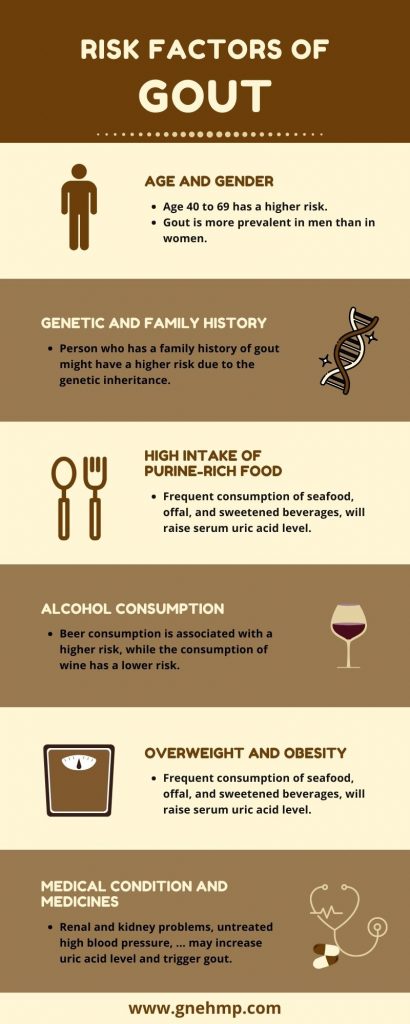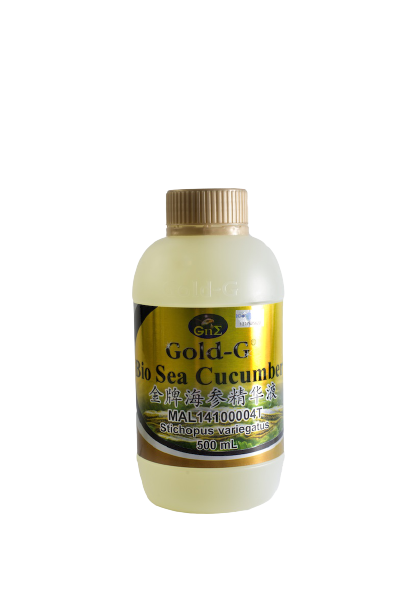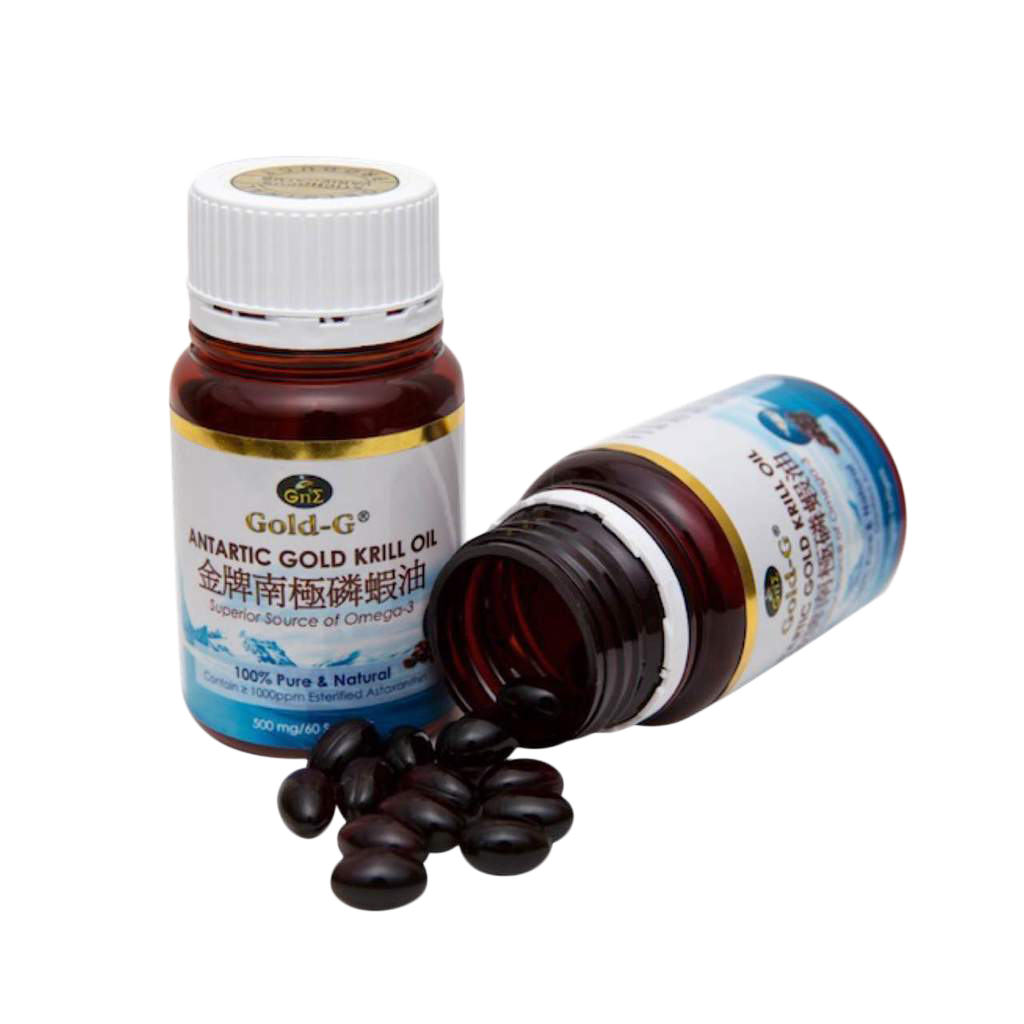Gout is inflammatory arthritis, which is also known as “the rich man’s disease” in the past, since the time of ancient Egypt, where it was thought to cause by consumption of a “rich” diet with a lot of meat and alcohol. In fact, gout is caused by high serum uric acid level in the blood. Uric acid is a waste product formed when the body breaks down purine. Purine is a substance that can be found in human cells and foods such as seafood, anchovies, meat, bone broth, beans, and nuts. Normally, after purine breaks down into uric acid, it will be dissolved in the blood and transported to the kidney, then excreted out from the body through urination. When the kidney failed to process it, uric acid will accumulate in the body, increase the serum uric acid level and lead to hyperuricemia. The excess uric acid will form needle-like crystals (a crystal of uric acid) in the joint at the finger, toe, ankle, or other lower body joints, cause gout with pain, redness, and swelling on the joint.
Signs and symptoms
- Intense joint pain
- Swollen joint (big toe)
- Inflammation and redness
- Lingering discomfort
Risk factors
Age and gender: Age range between 40-69 has a higher risk than the younger group. Gout is more prevalence in men than women, this might be due to the estrogen hormone in women has the role in regulating uric acid in the body.
Genetic and family history: A person who has a family history of gout might have a higher risk due to the genetic inheritance.
High intake of purine-rich food: Frequent consumption of purine-rich meat, offal, seafood, and sweetened beverages which contained fructose, can raise the serum uric acid level and increase the risk of gout, while purine-rich vegetables will not increase the risk of gout.
Alcohol consumption: Alcohol consumption may increase the risk of gout in various degrees, whereby beer consumption is associated with a higher risk than consumption of liquor, while consumption of wine has lower risk.
Overweight and obesity: Overweight and obesity causes the body to produce more uric acid, but the kidneys might have difficulty to eliminate the uric acid, hence will raise the serum uric acid level in the body.
Medical condition: Surgery, infection, renal and kidney problems, untreated high blood pressure, and metabolic syndrome may increase the uric acid level and trigger gout.
Medicines: Taking drugs such as cyclosporine or thiazide diuretics, which might cause increase of uric acid level in the body.
Diagnosis
- Joint fluid test
- Blood test
- Ultrasound
- Dual energy CT scan
- X-ray
Prevention and management
1. Drink plenty of water every day. Adequate fluid intake or drink at least 2 liters of plain water daily can help to reduce the risk of gout and prevent uric acid kidney stones.
2. Avoid sweetened beverages. Sweetened sugary beverages such as sodas, fruit juices, energy drinks, etc., especially those containing high fructose corn syrup (HFCS) may raise the uric acid level and increase the risk of gout. Also, fructose which may found in various fruits and honey can increase uric acid production by enhancing purine metabolism in the body. Hence, it is necessary to avoid over-consumption of fruits, and limit the consumption of fresh fruit juice, do not consume more than 1 glass of fruit juice per day.
3. Weight control. Maintain a healthy weight range is an effort to avoid and reduce the risk of diseases. Body mass index (BMI) is an indicator of the weight range, which is calculated using weight (kg) divided by the square of height (m2). For Asian, BMI value range from 18.5 to 22.9 is considered normal weight range; BMI value range from 23 to 27.4 is considered overweight; BMI value more than 27.5 is considered obesity; while BMI value less than 18.5 is underweight.
4. Limit intake of high purine food. Limit or avoid consumption of food high in purine such as meat (red meat and processed meat), organ meats, beans, lentils, seafood, and caviar. Besides, avoid bone broth or long-boiled soup, these dishes also high in purine content. However, consumption of purine-rich vegetables might not increase the risk of gout.
5. Limit alcohol intake. Alcohol consumption increases the risk of gout. Limit consumption of alcoholic beverages such as beer, liquor, vodka, wine, etc. Men should not consume alcohol more than 2 drinks per day; women should not consume more than 1 drink per day. The portion size of a drink is 12 oz (355ml) of beer, or 4 oz (118ml) of wine, or 1.5 oz (44ml) 80-proof spirits.
6. Consume foods that reduce uric acid. Cherry and cherry extract have uric acid lowering properties and protect against gout. Consumption of fruits and vegetables rich in Vitamin C such as berries, citrus fruits, and green leafy vegetables might be helpful. Besides, consumption of coffee might reduce the risk of gout. Coffee contains caffeine which potentially inhibits enzyme that breaks down purine into uric acid, hence lower uric acid in the body. Also, the consumption of low-fat dairy as a protein source instead of meat can reduce uric acid and lower risk of gout.
7. Supplements. High intake of Vitamin C, which is more than 250mg per day has been shown to have a protective effect against gout development. Vitamin C may reduce the uric acid level in the blood. Besides, some natural products such as longan seed extract, green tea (polyphenol), sea cucumber (saponin and polysaccharides) are potentially to inhibit the enzyme that breaks down purine and attenuate production of uric acid.
GNE Gold-G® Health Food Series:
Gold-G® Bio Sea Cucumber:
Gold-G® Bio Sea Cucumber is a health supplement containing high concentration of sea cucumber extract, which is rich in several pharmaceutical components that can protect against hyperuricemia, such as polysaccharide and saponin.
Sea cucumber polysaccharide and saponin could reduce the production of uric acid in the body. A study by Hao S. et al (2016) found that sea cucumber polysaccharide and saponin potentially downregulating uric acid level, where both can inhibit the activity of xanthine oxidase (XOD) which breaks down purine into uric acid, hence reduce the production of uric acid in the body. Besides, both can reduce the uric acid level in blood by downregulating glucose transport 9 (GLUT9) which play an important role in uric acid reabsorption.
Gold-G® Gold Krill Oil:
Krill oil is an increasingly important source of omega-3 fatty acids specific for DHA and EPA, contained abundant of astaxanthin, and consisted of phospholipids which provide better bioavailability.
Omega-3 fatty acids have strong anti-inflammatory properties, which able to fight inflammation, protect and maintain kidney health. It can improve blood pressure, which reduces the incidences of kidney diseases.
Astaxanthin is a strong antioxidant present in Antarctic krill oil. It can help to reduce inflammation and oxidation in the body, lower blood pressure and support kidney functions.
Click the link below for direct purchase.
References:
- Arthritis Foundation, (n.d.). Gout. Available at: https://www.arthritis.org/about-arthritis/types/gout/causes.php [Accessed 19/2/2019].
- Cleveland Clinic, (2019). High Uric Acid Level. Available at: https://my.clevelandclinic.org/health/symptoms/17808-high-uric-acid-level [Accessed 19/2/2019].
- Mayo Clinic, (2018). Gout. Available from: https://www.mayoclinic.org/diseases-conditions/gout/symptoms-causes/syc-20372897 [Accessed 19/2/2019].
- McIntos J., (2017). Everything you need to know about gout. Medical News Today. Available at: https://www.medicalnewstoday.com/articles/144827.php [Accessed 19/2/2019].
- Rymal E. and Rizzolo D., (2014). Gout: A comprehensive review. Journal of The America Academic PAs. 27(9), page 26-31. Available at: https://journals.lww.com/jaapa/fulltext/2014/09000/Gout__A_comprehensive_review.5.aspx#O3-5-4 [Accessed 20/2/2019].
- Ragab G., Elshahaly M., and Bardin T., (2017). Gout: An old disease in new perspective – A review. J Adv Res. 8(5), page 495 – 511. Available at: https://www.ncbi.nlm.nih.gov/pmc/articles/PMC5512152/ [Accessed 20/2/2019].
- Roddy E. and Choi H., (2014). Epidemiology of Gout. Rheum Dis Clin North Am. 40(2), page 155 – 175. Available at: https://www.ncbi.nlm.nih.gov/pmc/articles/PMC4119792/ [Accessed 20/2/2019].
- Hao S., Zhang C., and Song H., (2016). Natural Products Improving Hyperuricemia with Hepatorenal Dual Effects. Evid Based Complement Alternat Med. 2016:7350904. Available at: https://www.ncbi.nlm.nih.gov/pmc/articles/PMC5099468/. [Accessed 21/2/2019].
This website does not provide medical advice. The content of this website, such as graphics, images, text and all other materials, is provided for reference and educational purposes only. The content is not meant to be complete or exhaustive or to apply to any specific individual’s medical condition. Always seek the advice of your doctor or other qualified health provider regarding a medical condition.







